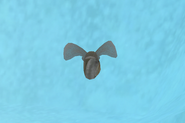The Sea Butterfly is a species of marine zooplankton. It only appears in Endless Ocean 2.
Marine Encyclopedia[]
Endless Ocean 2[]
Description[]
Location[]
Endless Ocean 2[]
The player can find small groups of sea butterflies under zoom-mode glows in the North Coast of Canada area, around coordinates B-1 SW, C-1 SW, D-2 SE, D-3 NW, and B-4 NE.
Behavior[]
These small creatures float about idly in loose groups under their zoom-mode patches. They like being given food.
Gallery[]
Notes[]
- These creatures are extremely small, and can therefore be hard to spot at first glance. It is also recommended that the player bring Oceana with them when searching for this creature, in order to make the zoom-mode spots they occur in more visible.
Real-Life Information[]
- This species was once believed to occur in both the Arctic and Antarctic oceans. However, around 2010 it was argued that the variety found around the south pole is genetically different enough from the ones found in the north to be classified as separate species[1]. These species are L. helicina in the Arctic, and L. antarctica in the Antarctic.
- Though they are most commonly associated with polar regions, sea butterflies can also be found off the coasts of the United States, Canada, and Japan[2].
- The name "sea butterfly" is commonly applied to the entire suborder that this specific creature belongs to, Thecosomata[3].
- This animal is considered a keystone species within its ecosystem[6], as it provides food to a myriad of Arctic species, from fish, to seabirds, to whales[7]. They are also the most bountiful pelagic sea snail in the Arctic[8], earning it the name "potato chip of the sea"[9].
- Much like several other species of gastropod[10], sea butterflies are hermaphroditic. This species in particular are protandrous hermaphrodites[8], meaning all individuals are born male, and may become female once they reach a large enough size.
- Sea butterflies are particularly at risk of extinction due to ocean acidification[6], as their shells are highly soluble, and require particular minerals to create that become more scarce as the ocean's pH decreases[7].
[]
Orange Sea Slug
• Orange and Black Sea Slug
• Festive Sea Slug
• Spotted White Sea Slug
Striped White Sea Slug
• Cinderella Sea Slug
• Strigate Chromodoris
• Luminescent Sea Slug
Parade-Float Sea Slug
• Venus's Flower Basket
• Branched Sea Slug
• Berthella Aurantiaca
Leafy Seadragon
• Weedy Seadragon
• Pygmy Seahorse
• Crowned Seahorse
• Spotted Garden Eel
Black Garden Eel
• Crystal Jelly
• Mauve Stinger
• Turritopsis Nutricula
• Moon Jellyfish
Nomura's Jellyfish
• Red Stingray
• Leopard Whipray
• Marbled Ray
• Cowtail Stingray
Blue-Spotted Ribbontail Ray
• Monkfish
• Broadclub Cuttlefish
• Broadclub Cuttlefish (young)
Bigfin Reef Squid
• Bigfin Reef Squid (young)
• Common Octopus
• Crown-of-Thorns Starfish
Sea Star
• Blue Sea Star
• Randall's Pistol Shrimp
• Goby Shrimp
• Ornate Spiny Lobster
Japanese Horseshoe Crab
• Red-Streaked Box Crab
• Spotted Box Crab
• Japanese Spider Crab
Ribbon Moray
• Kidako Moray
• Bering Wolffish
• Leatherback Turtle
• Green Sea Turtle
Sea Angel
• Sea Butterfly
• Hydromyles Globulosa
• Antarctic Krill
• Mertensia Ovum
Atlantic Spiny Lumpsucker
References[]
- ↑ Hunt B, Strugnell J, Bednarsek N, Linse K, Nelson RJ, Pakhomov E, et al. (2010) Poles Apart: The “Bipolar” Pteropod Species Limacina helicina Is Genetically Distinct Between the Arctic and Antarctic Oceans.
- ↑ Ocean Biodiversity Information System
- ↑ World Register of Marine Species
- ↑ World Register of Marine Species
- ↑ Sea Life Base
- ↑ 6.0 6.1 Comeau S, Jeffree R, Teyssié J-L, Gattuso J-P (2010) Response of the Arctic Pteropod Limacina helicina to Projected Future Environmental Conditions.
- ↑ 7.0 7.1 Center for Biological Diversity
- ↑ 8.0 8.1 Arctic Ocean Diversity
- ↑ Natureweb
- ↑ JOSEPH HELLER, (January 1993) Hermaphroditism in molluscs.





